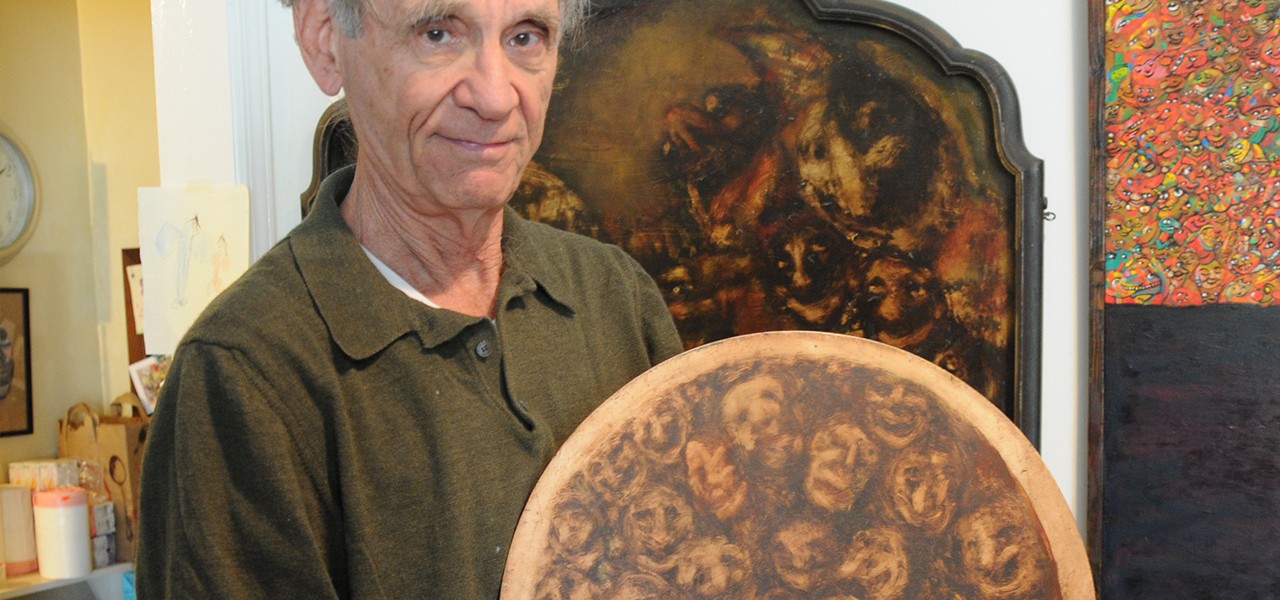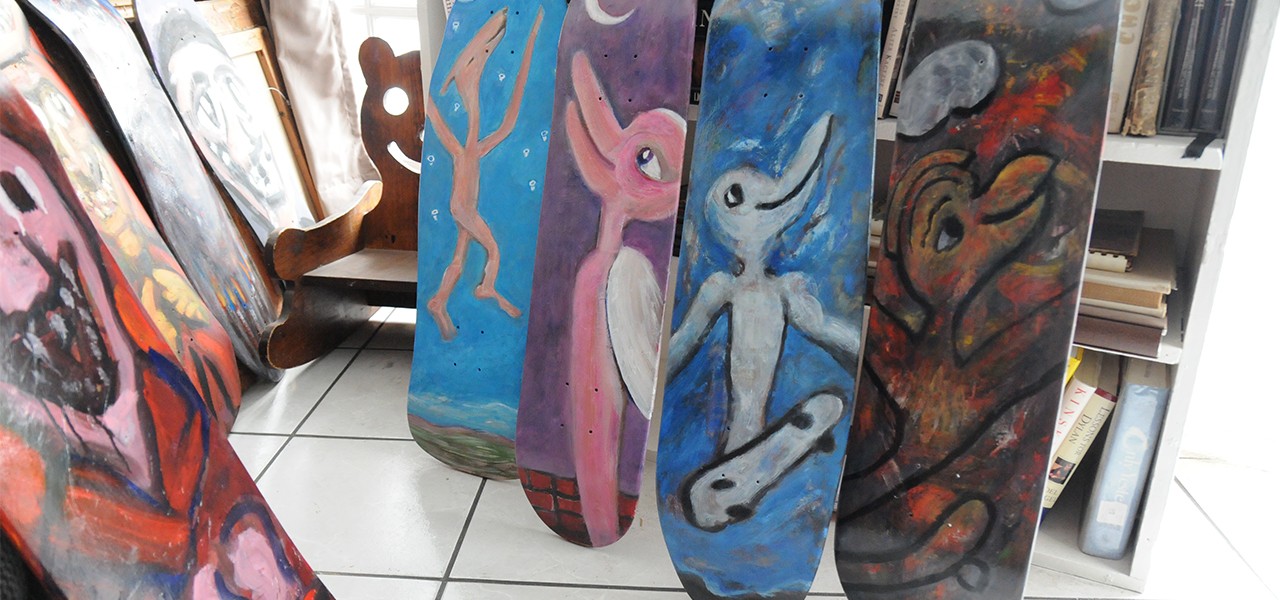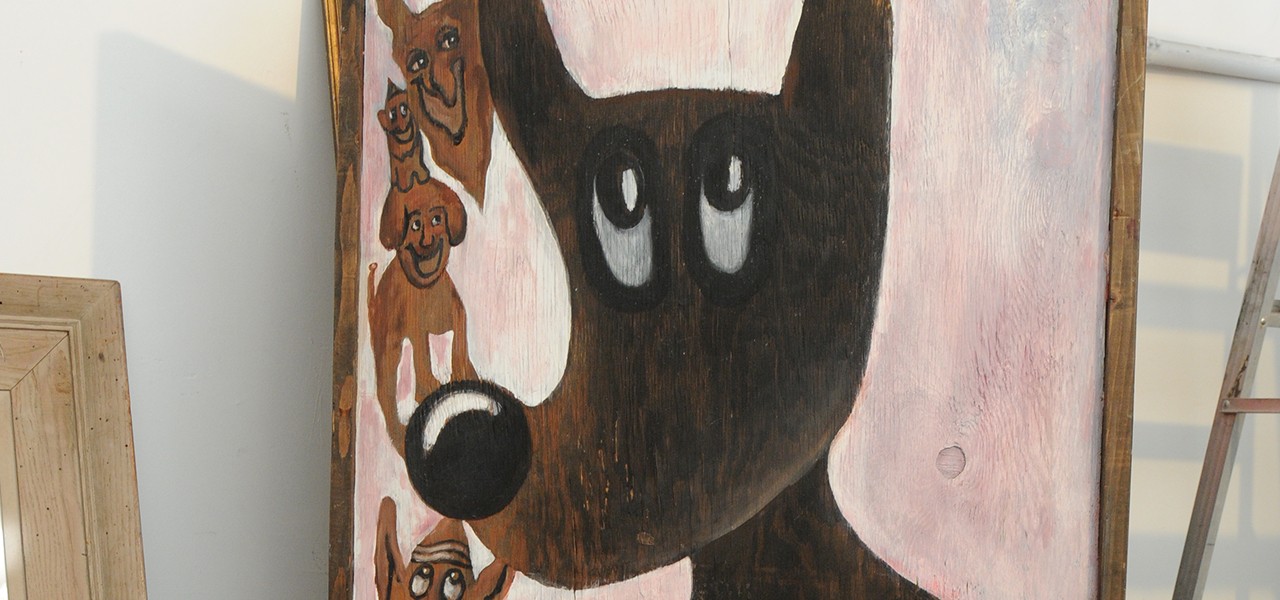
Harry Blitzstein, photo by Jürgen Blümlein
Harry Blitzstein could be one of the most interesting figures in urban art today – he is a former street artist and a painter based in Los Angeles, whose art still speaks the language of the streets. Even though his career was interrupted when he got caught writing graffiti, Blitzstein’s art is inherently related to and inspired by urban culture. However, we can safely say that this relationship is not that apparent, and it was first recognized and encouraged by Jürgen Blümlein, one of the founding members of the curatorial collective Faux Ami, who had met Harry in LA under some fateful circumstances. The practice of Faux Ami is based on the art and culture of skateboarding, and skateboarding is certainly one of the first things that comes to mind when talking about street culture. Harry’s approach and unique aesthetics resonated with this youthful, almost childish energy, so Jürgen suggested Harry to start painting on skateboards. And that is how Harry began producing unique, mesmerizing artworks which continue to inspire not only Jürgen and the rest of admirers of skateboarding, but also a lot of other people who are interested in street art. Correspondingly, the art of Harry Blitzstein was warmly welcomed by the team of Open Walls Gallery as well, and his body of work will be presented in an exhibition, starting on June 29th.
In the light of the upcoming show, getting to know Harry Blitzstein sounds like a good idea – and what better way than through a conversation with his very own curator, Jürgen Blümlein?

Harry Blitzstein artwork
Living in Los Angeles
Jürgen: Hey Harry. How are you? I hope you’re doing great! It’s freezing out here in Berlin right now. How is life in the sunny Los Angeles?
HB: LA is a good place to be, I think. I wanted to escape LA all my life because when I was in high school in the 1950s it was very smoggy here. The air was thick and gray and I thought that was just a part of life. But then there was a travel log in high school, which showed an Austrian village, and I thought, ‘Oh my god, how beautiful. It’s like living in a work of art – that’s where I wanna be! I’m gonna get out of here.’ The suitcase was on the floor, always with the lid open, and I would not own more clothes than could fit into it, and when I would look at it I would always think that, soon, I would be done writing and I would slam shut the suitcase and leave to Europe even if I went in only a T-shirt and Levi’s. That was my thing.
Jürgen: So did you ever make it out of LA?
HB: Because of my family responsibilities, it’s been a joke. The family joke is – I don’t get east of La Brea [Avenue]. (laughs) On top of it, I was living in my own world… You know, me being an artistic and poetic guy, I wasn’t really in the real world. I was off in dream land. The first guy that I fell in love with was Van Gogh. All my ancestors are from Europe, whether it’s Romania, and my father is from Lithuania, maybe the Russian area and Ukraine. So my people are from there, but also the art books I’m interested in – they are all European artists.
Jürgen: What kind of artists in particular?
HB: Cézanne, Soutine, Goya, Daumier, Dubuffet, all the European artists. So, spiritually, I am in Europe. Mentally, I’ve been in Europe and LA was just so provincial. So I thought, I can’t do anything here. However, over the past 20 years, LA has become such an international art market. Before, it was just the movies and celebrities. And I was a snob when it came to movies, it just had to be painting for me – not movies. But movies were here, fashion was here, there is so much in Southern California in the art scene and finally, the museums started to pick up and the artwork became international. But I didn’t really relate to the things going on here, I related to the Europeans. Still, today you can do anything in LA as art-wise, it’s open for you.
Jürgen: So it has become easier to be an artist living in LA?
HB: It’s a little hard to be understood here. Because the people here are still flying around on cocaine and movie deals, they are not really looking at the fine art. They don’t have a deep understanding of it, and yet with the modern stuff, wonderful things are happening here in the art field. But what’s more substantial, is an understanding of Cézanne (laughs).

Harry Blitzstein was influenced by the European artists
Harry Blitzstein’s Career Path
Jürgen: You brought up family ties earlier. How did your parents respond to your decision of being an artist?
HB: My mother was an artist, a painter. And I have many of her paintings in the tradition of Mary Cassatt and the Impressionists. Not totally trained, although she had turned down an art scholarship in order to go work. But she was an artist. When it came to me wanting an art studio behind my father’s shoe store, when it was available, [they said] no-no. They didn’t want me in the arts. They wanted me in the shoe business! (laughs) My mother wasn’t crazy about my art because I was a wild expressionist painter. And sometimes I painted ugly things and violent things and what I was going through, or what the world was going through. The wars and everything. Where she saw it as, ‘You do art, because you are painting a portrait of someone and you just love the portrait and the person loves it. And flowers. And happy and beautiful things.’ That was the type of beauty. And I couldn’t do it.
Jürgen: So the happy, joyful art wasn’t for you?
HB: I couldn’t do that. Nor could I do the exacting, tedious illustrations. Just perfect lines. Whereas I just want to take a brush as if it was sledgehammer. And I do all that without thinking. It’s just how I have to do it. Nothing is calculated, or planned out. It just doesn’t work when I try to plan it out. It gets boring. But when you are finding things that you didn’t expect then it’s kind of exciting. You try to break new ground. That’s why I’ve had several different periods in my art. I have done some kind of performance art which you have probably seen a few of – where I am painting the construction boards.
Jürgen: The street art?
HB: Yes, which I’m still working on. I’ve got a good one coming up. I want it ready for the show and show a DVD, if the gallery has the facilities for it. I’ll bring it along. On the other hand, the paintings that I’m doing for these skateboards, I began in 1967. And I really got big at it in 1972 and 1973 when I was doing the faces, like these ones. (Shows artwork). I was doing these way back in the 1970s, and of course they are not totally commercial but of course the young people liked them. These paintings are somewhat one of my characteristic styles. And they lend themselves to this exhibit. But then I also got to a point where I couldn’t paint these faces anymore.

Harry Blitzstein – Paintings or Skateboards
Paintings or Skateboards?
Jürgen: Now we’re making you do a whole lot of them.
HB: I’ve been at it since I got the assignment. I cleared up all those other paintings and that took about two weeks and for the last three months I’ve just been on skateboards, every day. And learning a great deal and loving it. I got to love it. I hit a point where I can’t do them anymore so I now I have to do my whimsical side, which would be like just this last dozens where kids would look at them and say, ‘Oh look dad, it’s an elephant with a little blue cap on.’ It’s an animal that’s flying in the air – I don’t know what it is – but it makes me happy. So I’m happy to work on these.
So much of art, whether an artist realizes or not, is autobiographical. It’s how you are feeling. The artists don’t even realize it. It’s really gutty to be an artist because you are exposing yourself. You’re saying, ‘This is my soul!’ You have to be a little courageous, but more crazy to be going through it. That’s how I see it. So these paintings reflect one of my major periods of art. Then also the whimsical side of me.
Jürgen: You say paintings – when other people may see skateboards?
HB: I treated these skateboards like canvases. To me, I couldn’t do it any other way. I just have to look at and see what I see and how I’m feeling and that comes out. So I treated them like canvases, the only way I could get it.
Jürgen: So you’ve always pursued your own way over the years?
HB: At one point a famous producer offered me a job as an art director after I did the artwork for his musical show. I turned it down and said, I couldn’t do it. All I wanted to do was paint. I had put off painting all through school so I could graduate in English and then I just said, ‘No I just want to be an artist.’ I was done with the army and everything and I said, ‘I just wanna paint.’ I turned down a teaching job at Indiana State right out of college. I loved to teach but I just wanted to paint.
I was teaching at the Parks & Recreation with little kids, teaching drawing and the class increased by ten times. I loved it. But I hit a point where I just wanted to paint and didn’t want to give my live to teaching. Because you can teach in other ways, too. One came to my parents house and offered me the teaching position, that was in 1967, and I said no, I just want to go into that studio.
Jürgen: Has your art changed over time?
HB: In 1964 it was still the beautiful romantic series and in 1967 there were just wild faces. It was a crazy time in 1967 and 1968. The Vietnam War was going on and the protests. I got out of the service a few years before in 1964. We were the good guys. Everything was beautiful and my paintings were romantic. But everything changed from 1967 on. That’s when I realized, these things were coming out, and I found myself laughing at these crazy faces. I didn’t want to think what they meant, but they made me laugh and I just wanted to keep painting them. That was my second period of art – those faces. Years later it lightened up and turned into more of a Disney approach, cause I was trying to be more accessible and get a little more happiness into my own life, so I painted them happier.
I had other periods where I did a speed painting thing. I recorded on video and painted as fast as I can. I just put some of it on Vine. Just to see what came out of the subconscious. The other periods where the Blitzorro series, which I had a kid doing. Because street art was getting big I thought, ‘Hey I’m 72 I’ll show those kids how to do it.’ And then I did my collage period, that was real big with me. The skateboards represent the work of the late ‘60s and ‘70s. And I just had a kick. Once I got into it I had a wonderful time and learning experience doing it and I thank you for that. I really thank you for getting me back into working again. Because once you are flowing with these, you move right up to the regular painting on canvas.

Harry Blitzstein artwork
Special Kind of Relationship
Jürgen: All the characters and paintings have names, right?
HB: Yes, back in the day my wife – when we first met – was my assistant and she worked for me for many years when I had my studio. And one of our favorite things was when the artwork was done, to think of the title. When you think of the title, you think of the meaning and what it’s about. And we would sit there and title it and think of the meaning of the picture. Years later, we tried marriage. We were just having a ball in the art world. It was a marriage in the studio. We tried marriage, even bought a house, and we had a child. The best child, a grown up son. But after fifteen years she said, ‘no!’ So we separated and she left. And a couple of weeks later we resumed our lives as assistant and painter. We still see each other every day but she finally just couldn’t live in the same house with me any longer. We have stayed married for almost 45 years.
Jürgen: That sounds like a special kind of relationship.
She is invaluable to me and if I can go my hardest and paint like a mad man and just let everything out, and I don’t have to worry that it’s going to embarrass me. Because Steffi will say, ‘That’s fine. It holds!’ Or she could be the critic and say, ‘This image is great but why do you have this other stuff in it? If you just clean this painting up, this one thing will stand out.’ So she has been not only my art editor but my advisor, my eyes. Frankly, like she says, she does everything for the paintings except physically paint them. That’s my job.
Jürgen: As I know she helped you with a tough decision for the novel you were writing.
HB: I went to Europe in 1964 for too brief a visit. I came home with the idea of finishing my novel in a month or 2 and then returning to live permanently and paint. Steffi moved in with me in 1970 when she turned 18. I was 32. We worked on my book, helped out in my dad’s shoe store on Fairfax and lived out of suitcases thinking in no time we would be leaving. I grew to hate the book because all I wanted to do was paint but I felt that if I didn’t finish the book I somehow wouldn’t deserve to paint. Finally in 1972 Steffi convinced me that it would not be the end of the world to forget the book and go back to painting and to stop torturing myself. We finally made it to Europe in 1975 to begin our lives. What was sad was that for 11 years I had dreamed of returning to Europe imagining it as a utopia. As things got worse in the USA (crime, traffic, inflation…) I didn’t take into account that Europe had changed too. We only lasted 4 months and then returned. Upon our return we took on the full responsibility of my elderly parents and disabled older brother. We had our wonderful son (now a professor at Harvard) and painted. Additionally, Steffi became a talented ceramicist and art teacher.
Jürgen: Does that help you focus?
HB: I don’t have to be intellectual. I don’t have to do any planning. I just have to go in there with the supplies and the paint and let it roll. And then she’ll say whether the paintings will live or die. Maybe I could get some perspective on them myself if I painted them and turned them around for three months and then turned them over again. But with Steffi, she can look at it while the paint is still wet and I can just rub it off. So it’s a collaboration art and we have gotten along very well. As far as my history goes, I went to Costa Rica and had a brief affair and a daughter, but my daughter Andrea’s mother passed away from a stroke at a very young age. But I have a wonderful son and a wonderful daughter and they each have two children, each a boy and a girl. So I’m complete, but my art career, although I have a following who support me somewhat, it hasn’t taken off how I wanted it.
Jürgen: Is there anything you’d change?
HB: I would really like some art shows, and I even had some projects in mind that you cannot do unless something big happens in the art world. I would love to teach art to kids on TV by going around to the major museums and having my little collage figures jump into the paintings, and say, ‘Hi kids! I’ll explain this painting to you.’ And just spontaneously go through the artists and kick it home. That was a project I had in mind. But you have to have a name to do these things. You have to have a name to publish your collage books. You have to have a name for the museum to accept a painting. Blah, blah, blah. Those are still my dreams and I’m still young! I’m only 27 plus 50! (laughs)
Jürgen: You still look young.
HB: Because I have been doing the same thing all this time. I’m the same, except you do get wiser every day and every year. Which is wonderful. Because when you are young, at least in my case, your mind is unformed and you do half-crazy things. And I had a real tough time like many of us do. But we all get wiser and we treat things differently and with more love as you learn with time.

Harry Blitzstein artwork
The Museum on Fairfax, or How Harry and Juergen Met
Jürgen: One thing I wanted to mention, which also brought us into your life, the day we passed by your gallery on Fairfax in 2009 and looked through your window. You have the museum on Fairfax, and first of all, the place is amazing!
HB: It is at your disposal if you want to skateboard in it!
Jürgen: Is it true the space was your father’s shoe shop?
HB: Yes, the third shoe shop. I grew up in Boyle Heights, East LA. The first shoe store was there on Whittier Boulevard, and the second one was on 1st Street. They were little family shoe stores, and went on for years. Eventually we moved over to Fairfax where the art gallery is. That was my father’s shoe store and that studio space in back was the one they initially wouldn’t let me have as an art studio. They rented it out for $40 a month and divided it with big boards and the guy from the Hungarian restaurant next doors would cook his baklava there in the oven. I was supposed to continue working in the business. And years later there was a big fire and when they rebuilt I made my studio in the back and the art gallery in front. Later on, due to family circumstances, I moved into my apartment house and gave up the studio in back and just have the art gallery on Fairfax.
Jürgen: Why did you name it a museum?
HB: I called it a museum because at the time I opened up there was nothing on this street than little grocery stores and fruit markets and little dress stores. Just a little neighborhood. There was nothing really cool about Fairfax. I thought that a “museum” would be such a stark contrast that it would create an interest and people would walk in. But nobody cared up there, they walked by.
Jürgen: But you watched the entire street change over the years?
HB: I didn’t even look! I’m just painting. Fairfax. I grew up there, it changes. If anyone can make a business on that street I’m happy for them. Every one of them. Of course I did see the changes. But for me it was a place where I met everyone in my life practically. People come in and they are attracted to art. People who aren’t afraid of art. Actors, writers. People in the arts would just come in to look at the art. The majority of people are intimidated by art, or they’re just not interested. They just keep on going – 85 percent of people just walk through there. But I met you!
Jürgen: That was fortunate.
HB: Initially I was going to name it the “Waiting for Eli Broad Gallery.” Hoping that would draw him in. With all his Jeff Koons and Warhols, and all these Seventies artists. But there are half a dozen reasons I put Museum of Art up there. People would come in from the art field and purchase something or give me a show so I just kept the place going, and it’s gotten better. And Sebastian ( Harrys gallery assistant ) has been a great help at keeping the place going and he has the buttons and the shirts and meanwhile I’m here devoting myself to the skateboards and doing some exercises. Because without the exercise I become stogy and don’t balance and focus as well on the art. And I’ve been busy with my grandchildren teaching them reading and playing basketball with them.
Jürgen: So with the art show in Berlin coming up, have you been to Germany before?
HB: No, just on the border. My only connection was in college, I wanted to be able to read Kafka in the original. I love languages and love the sounds of them and love to study them. I’m really looking forward to what you have planned in Berlin.
Jürgen: And we are looking forward to you have you over in here – First we take Berlin! Thank you Harry for your time!